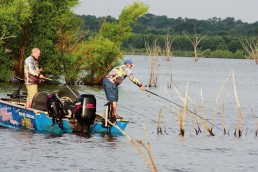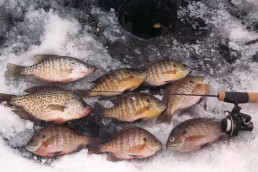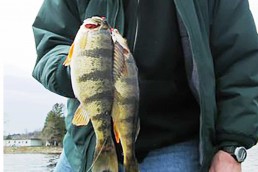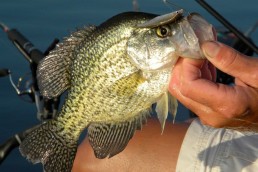Guides’ Hard-won Jigging Tactics Tackle Crappies
SHARE THIS POST
Dabbling, dipping, one-poling and jigging are just a few of the names used for presenting baits with a long pole. Jigging is a one-on-one challenge between a fisherman and a crappie. And, it’s fun, sporting and productive. Some parts of the country are better for jigging than others. Lakes with a little stain are good because fish are usually higher in the water column and less spooky than in clear water. Another factor is cover, and wood snags, stumps, lily pads, stationary docks, submerged brush piles, etc., are good.
The following fishermen are crappie-tournament experts from different parts of the country, but the same tactics apply no matter where you fish.
Adapt and catch
Iowa fisherman John Schantz calls Rathbun his home lake.
“I grew up fishing trees and it’s a fun way to catch crappies,” Schantz says. “Jigging lets you feel the bite and nothing else is like that.”
He prefers 6-pound-test line and 1/16-ounce jigs, but switches to a heavier jig in the wind. His favorite is a Slab Buster in Silver with an orange head.
He says there are a lot of things to do right and ones that are wrong when jigging near cover.
“Boat control is so important. I like to stay as far from the tree as possible so we don’t spook the fish. I start by dropping the jig slowly. When it stops, it is either a limb or a fish. I’ll then set the hook immediately.”
He says a hard hook-set is important. And he says since everything happens so quickly, it’s usually best to just get the fish into the boat like swinging a bass in.
Outlaw tactics
Whitey Outlaw of South Carolina says he loves feeling the initial hit that comes with jigging, and that it can’t be explained easily.
He uses a Buck’s BGJP graphite jig pole and the new Duck Commander pole, one at 11 or 12 feet in length. He likes a 1/16-ounce Rockport Rattler head with a Midsouth tube in their White/Chartreuse color combination.
Outlaw says the rattle head makes a huge difference, but timing is important too.
“Jigging on the right lake at the right time can be awesome. On a tournament day at Lake Fork, Texas we probably caught 175 fish. It was spawning time and once we found a bedding area, it was loaded.”
Are you enjoying this post?
You can be among the first to get the latest info on where to go, what to use and how to use it!
Outlaw says when fish are aggressive he power-fishes and drops the jig in for a few seconds then moves it to another spot. When fish are normal or slow he says you must slow your presentation down to a slow drop, shake the jig a little and then leave it still for as long as it takes.
“When setting the hook, I try to cross their eyes,” Outlaw adds. “You can do that with 10-pound-test line, big hooks and a limber pole. Then, snatch them right up and into the boat. In the Texas tournament, we didn’t lose one fish over 2 pounds swinging them in; I probably caught 90 percent of them right in my chest.”
Outlaw says a general tip for jigging is to pay attention to where fish are holding, and the type of cover and depth. Also, on cloudy days, fish out around the cover instead of right on it because the fish may be a few feet away.
Running and gunning
Truman Lake expert Kevin Rogers, along with his father Charlie, are known as two of the best jig fishermen in the country and are at it all year.
“When we are at a lake where fish are isolated to cover, we will be jigging,” says Kevin. “We do it year ‘round.”
Rogers prefers a 10-foot pole, Grizzly Elite reel and 15-pound-test SpiderWire braid. They like this line because it’s white, easy to see and is sensitive.
Kevin says his primary bait is a 1/4-ounce jig head with a 3-inch Bobby Garland Slab Slayer.
“We stick to the 3-inch Slab Slayer 95 percent of the time. Sometimes I’ll add a spinner on my line above the jig. I also use Mo’ Glo Slab Jam, a scent that will last for hours and it has glow in it.”
The team uses a run-and-gun style of fishing.
“We do fish fast,” Kevin said. “We try to find patterns and don’t waste time fishing other nearby stuff. There will be fish there that may not bite until a certain time of the day so we’ll hit spots over and over.”
He says that they may fish a spot five times before they get them to bite. Jigging can be productive and one of the most fun techniques for catching crappies. Some like the sporting aspect of using one pole, while others do it for just the excitement of feeling the “thump.” Multiple-pole fishing is here to stay, but a single-pole, one-on-one challenge is still a great way to fish.
MWO
SHARE THIS POST
Did you enjoy this post?
You can be among the first to get the latest info on where to go, what to use and how to use it!
Tim Huffman
Tim Huffman specializes in crappie fishing, is editor for two crappie magazines, as well as writing for several others. In 2018, he published his sixth book, Limiting Out for Crappie, available at Amazon. His first article appeared in MidWest Outdoors in 1988.



